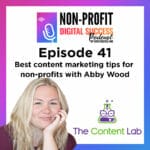
Although this article is focused primarily on health care, you can apply these to any organization.
Digitally enabled business and organization models have radically changed the world around us over the past decade, and the health care industry is no exception. In order to successfully engage with patients, in the background of the COVID-19 pandemic, this year as well as its long-term effects in the future, health care organizations and non-profits have witnessed the value of disruptive digital service models for the industry.
Improving patient experience through connected care models for preventive health, diagnosis, and treatment have benefited both providers and patients. This has led to HCOs building their online presence, through website development and social media profiles.
Having a great, user-friendly, informative website is incredibly useful. Unfortunately, it means very little if patients or potential clients cannot find the HCOs website online. This is because most people looking for information online will visit sites listed on the first page of search results. The Number 1 organic result is 10x more likely to receive a click from a search, while only 0. 78% of Google searchers clicked on something from the second page. However, to get on the first page, within the first ten sites listed there during an organic search, companies need a solid site, backed by an even stronger healthcare SEO strategy. SEO stands for Search Engine Optimization, which refers to both artistic and scientific techniques to rise to the top of organic search results on Google and across other major search engines.
“On a broad scale, I see SEO becoming a normalized marketing tactic, the same way TV, radio, and print are traditionally thought of as marketing tactics.”
– Duane Forrester
Senior Product Manager, Bing
In addition to traditional marketing mediums like TV, radio, and print, an SEO strategy for an organization’s online presence is required to prevent the loss of potential patients when they turn to the internet to do more research. With the implementation of a proper SEO strategy, an organization is able to market their facility to those who are already looking for the types of services and products they offer.
1. White Hat versus Black Hat SEO: Playing by the rules.
“My rule of thumb is build a site for a user, not a spider.”
– David Naylor Bronco.
CO. UK Managing Director
It is very tempting to jump headfirst into questionable SEO tactics or Black Hat SEO that is aimed to lure Google’s search engine spider or crawler (i. e. the technology through which Google goes through a website and determines its worth, and therefore it’s ranking). While doing this, one may gain in the short term, but this win is very hard to maintain. Search engine algorithms continuously change and update, making more concerted efforts to thwart black hat SEO tricks. So, it makes more sense to invest in a solid, long term, knowledge and expertise-based SEO plan, or White Hat SEO, that remains evergreen. Website design optimization done the right way will convert traffic into leads and conversions, which can reflect increased patient inflow, improved interest from donors or stakeholders, and increased industry notoriety, in healthcare organizations.
2. Getting down to basics: Onsite SEO techniques
SEO starts from the ground up, which means optimizing the code, images, words, and backend operations that make up a website. From the type of content displayed to the site loading speed and mobile responsiveness, there are a variety of factors that impact aspects of SEO and therefore rankings.
- Title Tags are coding elements that specify the titles of a website or webpage and are displayed on SERPs (Search Engine Results Pages) as the clickable headline for a given search result. Title tags between 15 and 40 characters generate clicks.
- SEO Metadata or Description Tags: show up just beneath the title tags in SERPs, and are short descriptions that summarize the contents of the webpage. Pages with a meta description get 8% more clicks than those without a description.
- Site Speed or page speed is a measurement of how long it takes for web pages to load. Sites with faster site speeds generally rank higher in SERPs.
- Mobile Responsiveness determines how well a website adapts its format to be optimally viewed on various mobile devices.
- Keyword Meta Tags aren’t visible to online visitors, but seen by search engines to indicate which searches will be relevant to the website.
- Alt Tags is a coding attribute that is applied to image tags to provide a text alternative for search engines.
- H1’s and H2’s are header tags which are used to communicate to search engines what the website is actually about.
- Sitemaps: A coded sitemap, on the website’s backend, is an invitation for search engines to crawl the URLs or links that are listed within that site. While a visible site map helps to organize a website to enhance the user experience so that visitors can navigate the site easily.
- Backlinks: Websites that are linked to other relevant healthcare-related websites are considered more valuable to Google than sites without any of these backlinks. The backlinks should be relevant to the theme or niche of the website because it gives web pages authority and credibility.
3. Content is King: Keep visitors coming back for more
Once visitors find their way onto your website, they need to have a reason to stick around. Captivating content never fails to impress. This can be varied, making use of different media like written content for blogs, FAQs, white papers, e-books. Or, making use of videos, images, infographics, and audio, on websites as well as social media channels to improve patient engagement and therefore, rankings.
“SEO and content marketing will continue to drive visibility in 2020 but what good is being found if the content is not credible or compelling? To win the content marketing game, brands need to focus more on optimized, personalized and influencer activated content experiences.”
– Lee Odden.
CEO, Top Rank Marketing
Blogs and articles help position websites as relevant answers to patients’ common problems, questions, or doubts. Organizations that blog regularly with fresh, informative content receive 13 times the Return On Investment of businesses that don’t. The key elements to consider here are consistency and value, to resonate with target audiences.
On healthcare organization websites, the power of testimonials plays a very important role in lead generation and patient conversion. Reviews and testimonials through physician-rating websites are also an interesting source of information about the quality of health care from the patient’s perspective. Data shows that 84% of patients use online reviews to evaluate physicians, while 77% of patients use online reviews as their first step in finding a new doctor. Search engines are also making use of healthcare directories to determine the ranking, using practice, clinic, or organizational listings and ratings in these directories to evaluate a website’s performance. The integration of social media channels in websites, improves the impression of reliability and popularity, using matrices like the number of likes and follows as indicators for content value as well as patient and community engagement.
4. The Medic Algorithm
As the world’s most widely used search engine, Google tries to continuously improve their search results in order to provide the most relevant, useful, and accurate content to people who use their platform. This is why they continuously change their algorithm and each update affects the rankings of websites or pages listed, depending on the quality of their content as well as the efficiency of their SEO.
While this may be perceived as a way to reward White Hat SEO tactics and thwart Black Hat SEO attempts, Google seemed to aim further. With a major rehaul in 2018, dubbed as the Medic Update, the search engine introduced new parameters for webpage ranking, putting more focus on authentic medical news and information. The update seemed to value relevancy, along with expertise, authority, and trustworthiness of the website, and changed rankings accordingly, almost overnight. (the E-A-T formula). This was followed by updates in January and May 2020, where the driving force seemed to be to demote the sites that were publishing harmful misinformation or medical advice related to the COVID-19 pandemic.
“Google has told us that their main goal is to better understand queries and also to better understand which content is high quality. The key to improved rankings in 2020 and beyond is tied to truly producing content that is more helpful than what already exists.”
– Marie Haynes.
5. Matrices to measure an effective medical SEO strategy
“What gets measured gets improved. ”
– Peter Drucker
Even more important than rankings, is measuring website traffic from SEO and as well as website conversions due to SEO. These are some important data points to analyze and improve upon.
- Increase in lead volume.
- Increase in walk-in patients – track by brand conversions.
- Increase in organic web traffic – keep an eye on the bounce rate.
- Increased patient conversion – leading to more admissions/surgeries/treatments per month.
- What keywords seem to be working and what do not?
- What is the bounce rate of the site?
- What page are users landing on most often?
Tangible benefits of medical SEO do for healthcare organizations
- Build trust among prospective patients and attract new patients through search engine results
- Educate healthcare consumers about the organization or clinic and medical conditions that are treated there
- Educate patients about their own health
- Increase brand recognition and stand out from the pack
- Invite referrals from other physicians and patients
- Encourage existing patients’ continuing trust in the organization
- Reduce marketing costs while still attracting more patients. It is a longer-term play over paid search, but in the grand scheme of things it can produce a substantial and consistent return on investment.
Search engine optimization may seem like a complicated web of technical jargon that overwhelms medical professionals and healthcare administrators, however, the value that it brings to a marketing strategy is undisputed. Keeping up with algorithm changes to maintain high Google rankings, is challenging, but the key is to always provide value-based content for patients and the community to engage with. At Wow Digital, we provide expert SEO consultation to elevate website performance and marketing strategies of healthcare organizations.









0 Comments
Trackbacks/Pingbacks